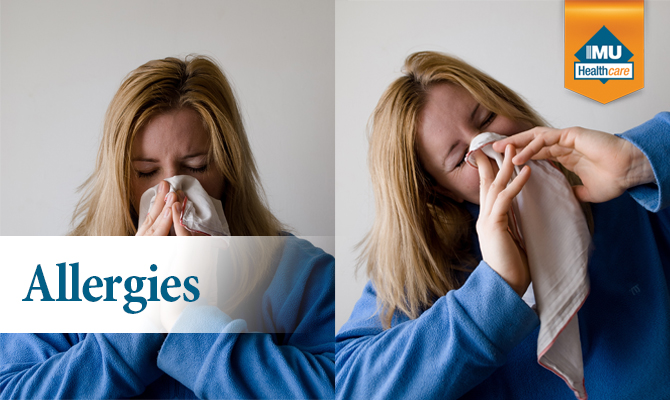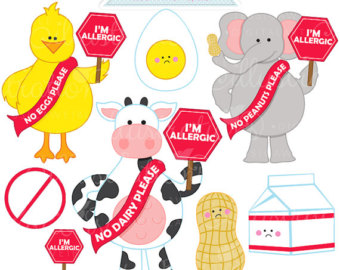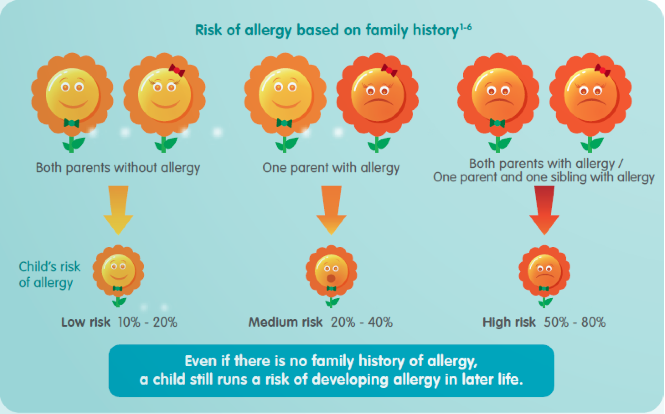Sneezing when you smell belacan being fried is a common occurrence. The same goes for sneezing when dust gets into your nose. Anything that irritates your nose can make you sneeze. It is your body’s way of protecting you from the irritant. However, when sneezing becomes a daily affair or when it affects your daily function, it may be a more serious matter; it may be an allergic reaction.  Allergies are among the most common chronic conditions worldwide. Allergy diseases are affecting the lives of more than one billion people worldwide. With an epidemic rise during the last 60 years, their prevalence is expected to reach up to four billion in 2050*. It is of little surprise that one in five Malaysian children are at risk of allergy**. Allergy symptoms range from making you feel miserable to putting you at risk for life-threatening reactions.
Allergies are among the most common chronic conditions worldwide. Allergy diseases are affecting the lives of more than one billion people worldwide. With an epidemic rise during the last 60 years, their prevalence is expected to reach up to four billion in 2050*. It is of little surprise that one in five Malaysian children are at risk of allergy**. Allergy symptoms range from making you feel miserable to putting you at risk for life-threatening reactions.  An allergic reaction begins in the immune system. Our immune system protects us from invading organisms that can cause illness. If you have an allergy, your immune system mistakes an otherwise harmless substance as an invader. This substance is called an allergen. The immune system overreacts to the allergen by producing Immunoglobulin E (IgE) antibodies. These antibodies travel to cells that release histamine and other chemicals, causing an allergic reaction. An allergic reaction typically triggers symptoms in the eyes, nose, sinuses, throat, lungs, lining of the stomach or on the skin. The body reacts by making you sneeze or itch and in worse case scenarios it can cause swelling or inflammation which could obstruct the airways, thus making it more difficult to breathe. This is when having allergic reactions can be life-threatening, necessitating immediate medical intervention.
An allergic reaction begins in the immune system. Our immune system protects us from invading organisms that can cause illness. If you have an allergy, your immune system mistakes an otherwise harmless substance as an invader. This substance is called an allergen. The immune system overreacts to the allergen by producing Immunoglobulin E (IgE) antibodies. These antibodies travel to cells that release histamine and other chemicals, causing an allergic reaction. An allergic reaction typically triggers symptoms in the eyes, nose, sinuses, throat, lungs, lining of the stomach or on the skin. The body reacts by making you sneeze or itch and in worse case scenarios it can cause swelling or inflammation which could obstruct the airways, thus making it more difficult to breathe. This is when having allergic reactions can be life-threatening, necessitating immediate medical intervention.
While certain food and environmental factors may play a part in causing allergies in children, there is one other culprit that plays a significantly huge role as well. And that is none other than…family history. The risk of allergy based on family history is depicted below
Source: The Malaysian Society of Allergy and Immunology (http://www.allergymsai.org/childhood_allergy.htm)
What many people do not know about is the Allergy March. Allergies and their symptoms often appear in a particular sequence during childhood, and this progression of the symptoms and allergic disease is known as the Allergy March. Children often develop one set of allergy and symptoms in an order related to their age and development. The word ‘march’ suggests that children pass through each of these stages. However, sometimes a child will take the allergies and symptoms from one stage with them, as they grow older and develop other allergies and symptoms. In this way, allergies and atopic diseases can overlap.
Source: The Malaysian Society of Allergy and Immunology (http://www.theallergymarch.com/theallergymarch_booklet.pdf)
Some of the most common allergens are dust mites, pollen from flowers and plants, mold and mildew, as well as latex. Foods that might trigger allergic reactions include milk, wheat, soy, eggs, nuts, seafood, and legumes. Most people associate being allergic to sneezing. However, an allergic reaction can come in the form of a runny nose or wheezing. Eczema, urticarial (hives) and conjunctivitis (pinkeye) are other conditions caused by allergy. Tests for allergies are not very useful in managing allergic illnesses in both children and adults. Getting the accurate story is the utmost important. A doctor will ask the patient about family history, the story of the allergy, lifestyle and family living conditions, along with questions about the environments they work, study and live in. There are two tests doctors may use to identify the allergens a person react to: a skin prick test or a blood test. Skin prick or scratch test is when the doctor puts a tiny amount of various substances on a patient’s arm or back and allows them to enter the body by pricking or scratching the skin with a needle. Within about 15 minutes bumps form on the skin if the patient has allergy to any one or more of the substances. The blood test involves testing patient’s blood for antibody levels to various substances or antigens.
Unless allergies result in life-threatening conditions, many people opt for proactive methods of control. This means identifying and avoiding food or environmental allergens that cause the allergic reaction, or ensuring they have medication on hand to control the symptoms.
Knowing your allergens, and working on a plan to treat the symptoms early will help mitigate severe health problems associated with allergy. For example, take a person who always wakes up in the morning with watery eyes and runny nose. An allergy test may help confirm if the person is allergic to dust, dust mites, or even latex, if they happen to be sleeping on a latex mattress. Having identified the allergen, the person can make significant changes in their sleeping area which will result eradicating or minimizing the allergen. This in turn helps the person to sleep better, and wake up without symptoms. A doctor may prescribe anti-histamines, decongestants, or bronchodilators which relieve the symptoms of allergic reactions with or without steroid to prevent and control the illness. The key takeaway message in identifying your allergies is that you need not have to suffer. There is something that can be done, and it requires you to play your part to put yourself on to the path to a more comfortable, allergy-free life.
* The European Academy of Allergy and Clinical Immunology (EAACI). Global Atlas of Allergy. (2014). http://www.eaaci.org/globalatlas/GlobalAtlasAllergy.pdf
** The Malaysian Society of Allergy and Immunology (MSAI). http://www.allergymsai.org/
This article is brought to you by IMU Healthcare.












